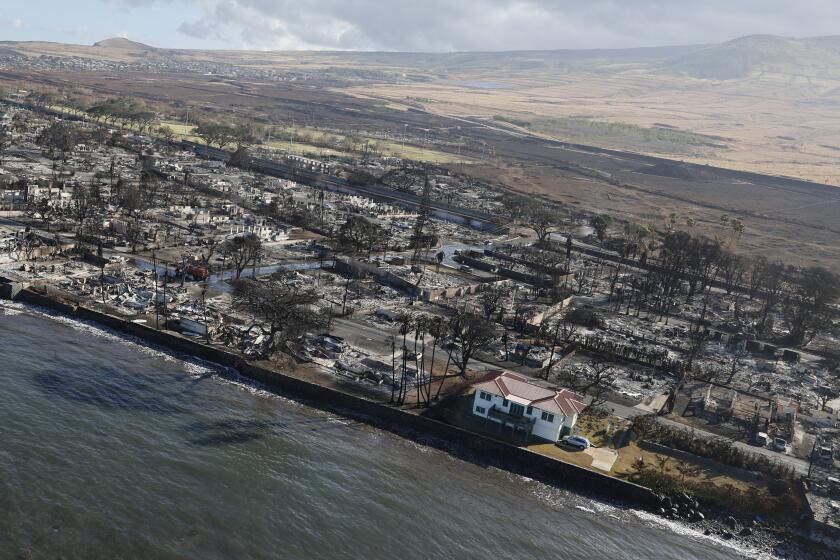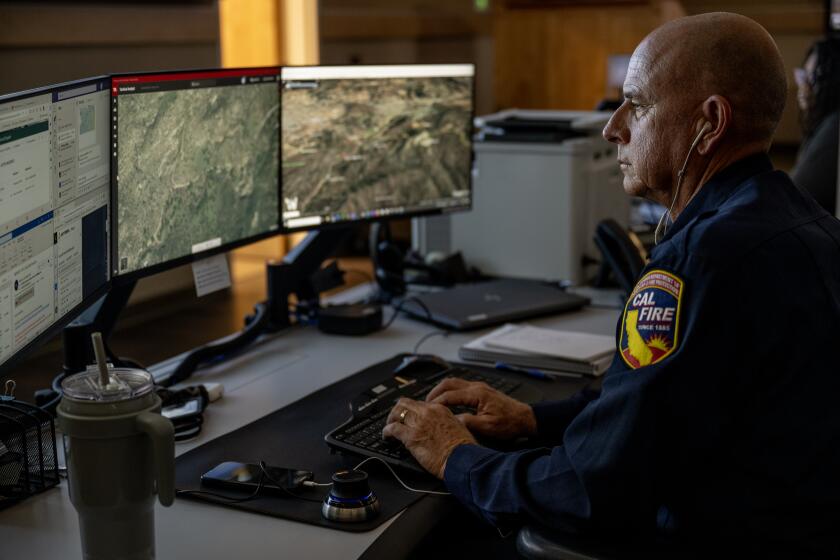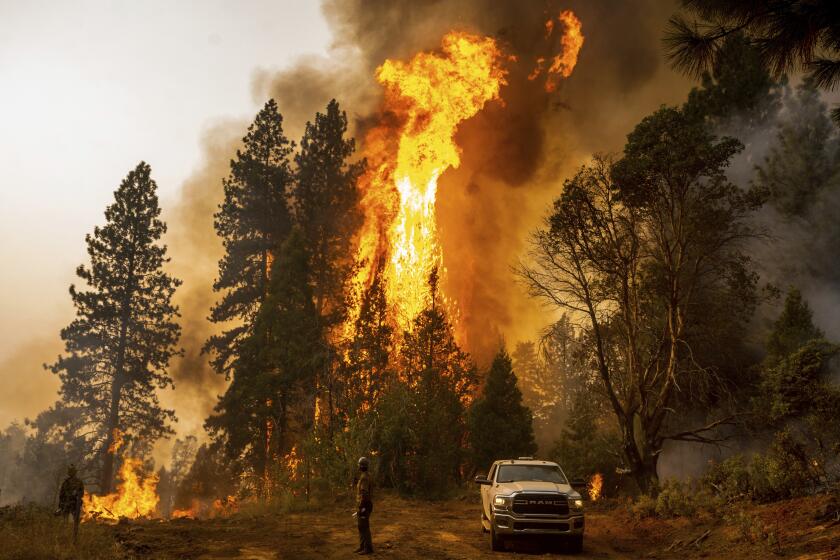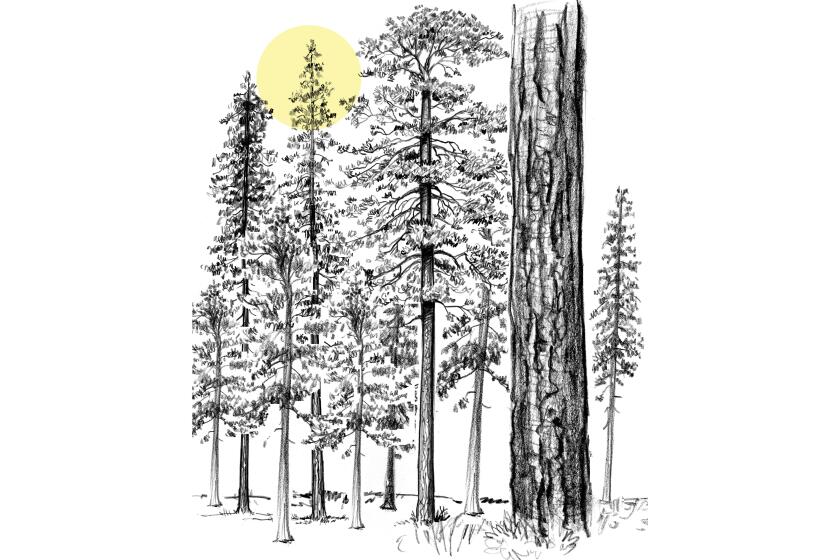Climate change boosts risk of explosive wildfire growth in California by 25%, study says
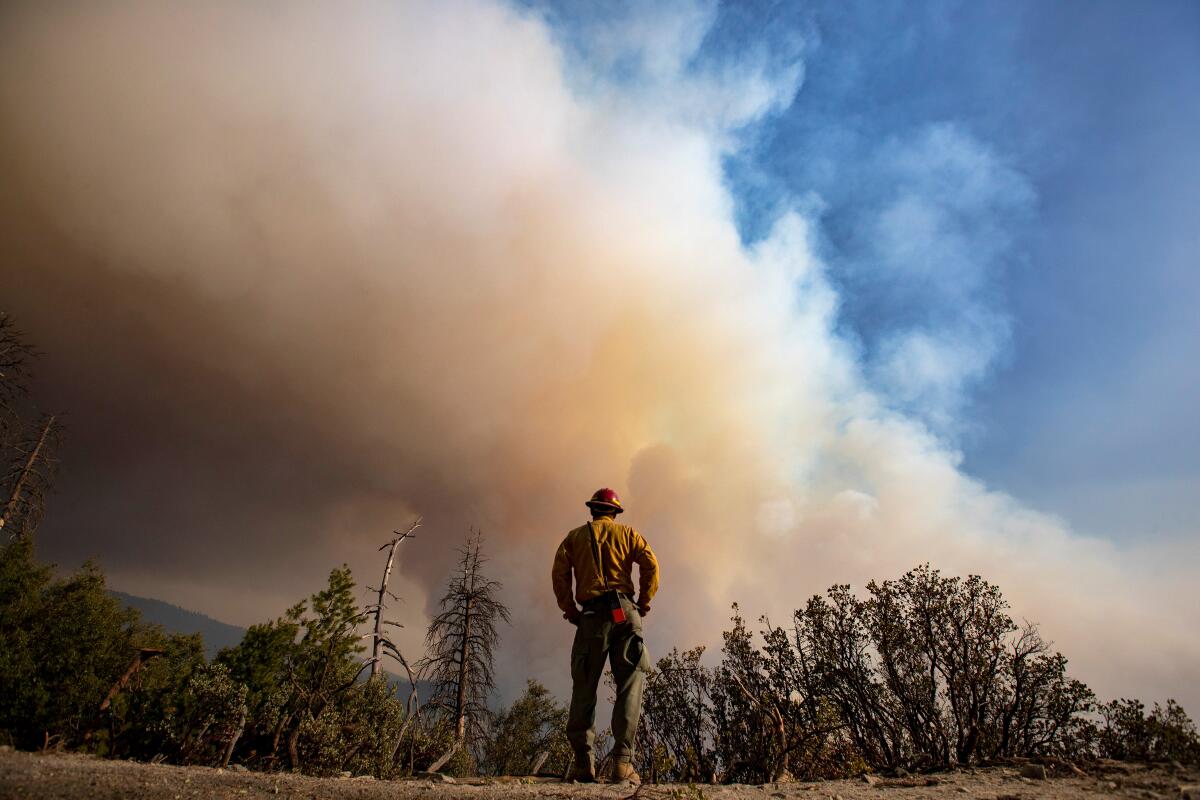
- Share via
Climate change has ratcheted up the risk of explosive wildfire growth in California by 25% and will continue to drive extreme fire behavior for decades to come, even if planet-warming emissions are reduced, a new study has found.
“Emissions reductions have a minimal impact on wildfire danger in the near term — the next several decades,” said author Patrick T. Brown, co-director of the climate and energy team at the Breakthrough Institute, a Berkeley-based think tank. “So it’s important to look at more direct on-the-ground solutions to the problem like fuel reduction.”
Although previous studies have looked at the impact of climate change on broader metrics like annual area burned, as well on conditions that are conducive to wildfires, like aridity, the research published Wednesday in Nature drills down on how rising temperatures affected individual fires, and how they might continue to do so in the future.
The researchers analyzed nearly 18,000 fires that ignited in California between 2003 and 2020. Using artificial intelligence, they had models learn the relationship between temperature and extreme fire growth, which they defined as more than 10,000 acres in a day. They then simulated how those fires would behave under pre-industrial conditions, as well as a host of potential future conditions.
They found that climate change raised the risk of extreme daily wildfire growth by an average of 25%, in the aggregate. But the exact influence varied greatly from fire to fire — and even from day to day.
A red-roofed house appears untouched amid the devastation of the Lahaina fire. Its owner says recent renovations may have helped make it fireproof.
For example, if a fire ignites right after a rainstorm, the risk of extreme growth often remains relatively low, regardless of warming, said Brown, who is also a visiting research professor at San Jose State University and a member of the Wildfire Interdisciplinary Research Center. Conversely, if conditions are very dry, the risk is generally high, also regardless of climate change, he said.
“Where if conditions were pretty dry but not super dry then the background warming kind of pushed you over a critical threshold of drying or aridity and caused a large increase in the probability of extreme daily fire growth,” he said.
Brown likened it to the question of whether gaining a few inches in height would help a person dunk a basketball.
“If you’re 5 feet tall, growing a couple inches doesn’t affect your ability to dunk, and if you’re 8 feet tall, it doesn’t affect your ability either,” he said. “You have to be right on that critical threshold for the growth to affect your ability to dunk the ball.”
Higher temperatures alone do not increase fire danger — they do so by drying out vegetation, Brown said. That’s in part because of heat’s effect on the vapor pressure deficit, which is basically a measure of how thirsty the atmosphere is, he said. Warmer air can hold more moisture, meaning that it sucks more water from soil and plants, priming landscapes to burn.
In fact, previous studies have found the vapor pressure deficit to be the leading meteorological variable that controls how much land burns in the western U.S. during a given fire season — and that climate change is boosting the deficit upward.
Cal Fire is the first fire agency to use artificial intelligence to look for signs of wildfires and directly alert dispatch centers.
By looking at how warming affected past fires, Brown’s study highlights how climate change is already making our world more combustible, said Neil Lareau, professor of atmospheric science at University of Nevada-Reno, who was not involved in the research.
“It provides a nice framework for quantifying some of the things that we already intuitively know and feel like we’re seeing in California, in particular this impact of increasing heat on driving extreme fire behavior,” he said. “I think a lot of us have kind of experienced that on a visceral level over the last decade.”
Firefighters have had a front-row seat to this shift as they’ve been tasked with battling more fast-moving fires that are burning “multiple thousands of acres per burn period,” said Capt. Robert Foxworthy, a public information officer with the California Department of Forestry and Fire Protection.
“I’m not a scientist so I can’t say exactly what’s causing it but what I have seen in the last 10 or so years is that things are changing,” he said. “We have seen more of these larger fires that are growing faster and burning more acres in a shorter amount of time.”
The faster a fire moves, the more difficult and dangerous it is to fight because it can jump ahead of firefighters and outpace their efforts to contain it, he said.
“Inevitably, when speed picks up, so does intensity,” he said. “And the more intense a fire is, the harder it is for crews to be able to get right on that fire’s edge to put it out. It can move faster than those crews can get fire hose on the ground or drive a fire engine next to the flames and squirt water on them.”
Fast-moving fires can also catch residents off guard, forcing firefighters to switch focus from battling the flames to conducting evacuations and rescues, he said.
“I like to tell the public that these fires are burning fast, faster than we’ve seen as firefighters,” he said. “So when you’re asked to evacuate, please do it because the next thing you know, that fire can be right on you and surprise you with how quick it’s moving.”
Carbon emissions from fossil fuels and cement production are making western forests drier and more susceptible to wildfire, researchers say.
Brown’s research team found that warming substantially increased the extreme growth risk of several lightning-sparked complex fires in 2020, including the LNU Complex — by 42% — and the North Complex — by 40%. These fires ignited during what was then the state’s hottest August on record.
But climate change had less of an effect on the extreme growth risk of other devastating fires. The 2018 Camp fire, in which climate change increased the risk by an estimated 14%, was stoked by very dry vegetation and high winds, by some accounts burning roughly 80 acres per minute.
“The Camp fire occurred under very dangerous conditions and so that lower number indicates that even in a pre-industrial climate they would have been very dangerous conditions,” Brown said. “So the influence of climate change on that fire is not very large.”
The machine learning approach is a nice way of capturing some of the interactions between fire, fuels and the atmosphere, but it also has shortcomings, Lareau said. With the exception of temperature, the researchers held everything about historical conditions constant, including ignitions, winds and precipitation.
“But there are other things we don’t know about how the climate system is going to change, and that’s kind of underlying uncertainty,” Lareau said.
One example, he said, is that extreme temperatures and drought result in increased tree mortality, which provides more fuel for fires. Warming could also affect precipitation and wind patterns, but that is uncertain and not well understood. If anything, he said, not accounting for these changes likely resulted in somewhat conservative estimates of the effect of climate change on fires.
“I think it’s still a really important approach to not get bogged down in the things we can’t know and instead focus on the role heat is going to play in making the world more flammable,” he said.
The researchers estimate that climate change will raise the risk of extreme daily wildfire growth by an average of 59% by the end of the century if emissions reach net zero in the 2070s. If emissions continue to rise until 2050, climate change will raise the risk by an average of 90%, according to the study.
One thing that’s important to note, Brown said, is that both the low and moderate emissions scenarios look virtually identical in the middle of the century when it comes to wildfires. Although there are other important reasons to cut emissions, doing so will not affect fire growth in people’s lifetimes, he said.
As California struggles with an increase in extreme wildfires, researchers are studying exactly what a healthy or fire-resistant forest looks like.
“It’s just that it takes so long for emissions reductions to imprint on temperature,” he said. “I’m trying to dispel the notion that we can see an increase in wildfire danger, then go and pass climate policy and see some effect of that climate policy right away.”
“That’s why we need to look at more direct, on-the-ground solutions like prescribed fire and mechanical thinning,” he added.
With that in mind, Brown and others with the Wildfire Interdisciplinary Research Center have moved on to a new phase of research. They are now assessing the effect of prescribed burning and mechanical thinning on wildfire danger by simulating how forecasted weather conditions would play out in different combinations of climate and vegetation states.
“The good news is that the same model setup finds the fuels have just a huge impact on fire danger,” Brown said. These preliminary results point to the urgent need to scale up burning and thinning projects, he said.
“If we were able to do that, we could more than offset the impact of climate change such that we get a net reduction in wildfire danger despite climate change,” he said.
More to Read
Sign up for Essential California
The most important California stories and recommendations in your inbox every morning.
You may occasionally receive promotional content from the Los Angeles Times.
